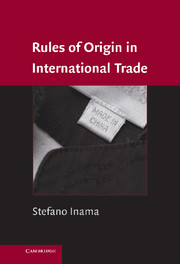Book contents
- Frontmatter
- Contents
- List of Figures
- List of Tables
- List of Acronyms
- Preface
- 1 Efforts to Establish Multilateral Rules
- 2 The Uruguay Round Agreement on Rules of Origin: The Harmonization Work Program of Nonpreferential Rules of Origin
- 3 Preferential Rules of Origin
- 4 The Economics of Rules of Origin
- 5 Drafting Preferential Rules of Origin
- 6 The Administration of Rules of Origin
- Index
6 - The Administration of Rules of Origin
Published online by Cambridge University Press: 18 August 2009
- Frontmatter
- Contents
- List of Figures
- List of Tables
- List of Acronyms
- Preface
- 1 Efforts to Establish Multilateral Rules
- 2 The Uruguay Round Agreement on Rules of Origin: The Harmonization Work Program of Nonpreferential Rules of Origin
- 3 Preferential Rules of Origin
- 4 The Economics of Rules of Origin
- 5 Drafting Preferential Rules of Origin
- 6 The Administration of Rules of Origin
- Index
Summary
An important element of the rules of origin is their administration. Rules of origin are one of the three basic customs law: The Harmonized System (HS) for customs classification, customs valuation, and rules of origin. These customs laws are designed to assist the customs officers in responding to basic questions: Where do I classify these goods? How much are they worth? Where are they coming from?
In day-to-day business life, rules of origin are part of the border routine and they need to be administered in an efficient manner to facilitate customs clearance and not to cause hindrance to trade.
The administration of rules of origin is usually centered on three stages: (1) the issuance of the documentary evidence proving origin, that is, the certificate of origin, (2) direct consignment conditions and related documentary evidence, and (3) verification and postclearance recovery procedures.
There are not multilateral rules on administering rules of origin. On the one hand, the World Trade Organization (WTO) Agreement on rules of origin is conspicuously silent in this regard. On the other hand, the Kyoto Convention provides only guidelines. Meanwhile, the flourishing of free-trade areas (FTAs) Agreements entails the negotiations of rules of origin as well as their administrative requirements with almost total lack of multilateral discipline.
Many of these FTAs are replacing former unilateral preferences.
- Type
- Chapter
- Information
- Rules of Origin in International Trade , pp. 530 - 606Publisher: Cambridge University PressPrint publication year: 2009



